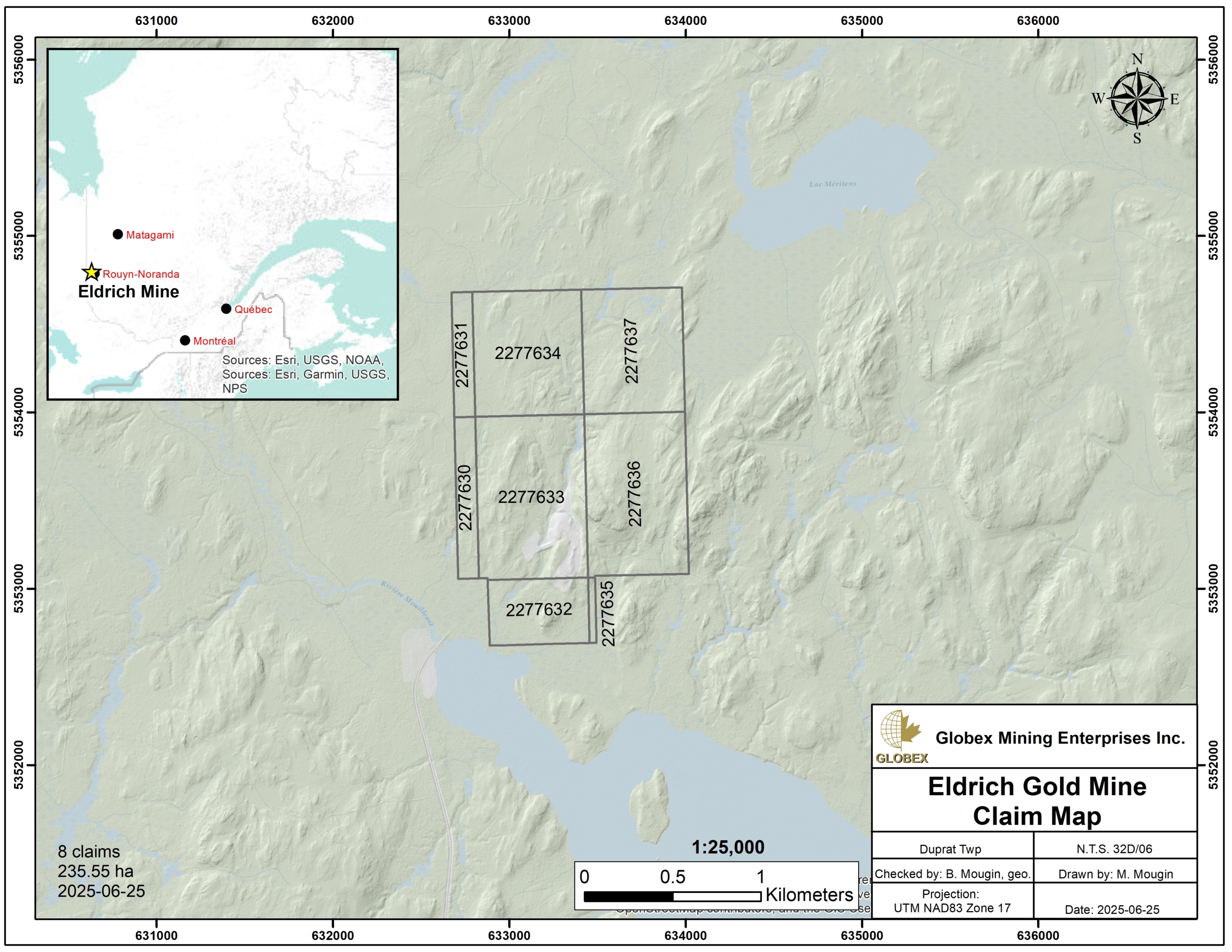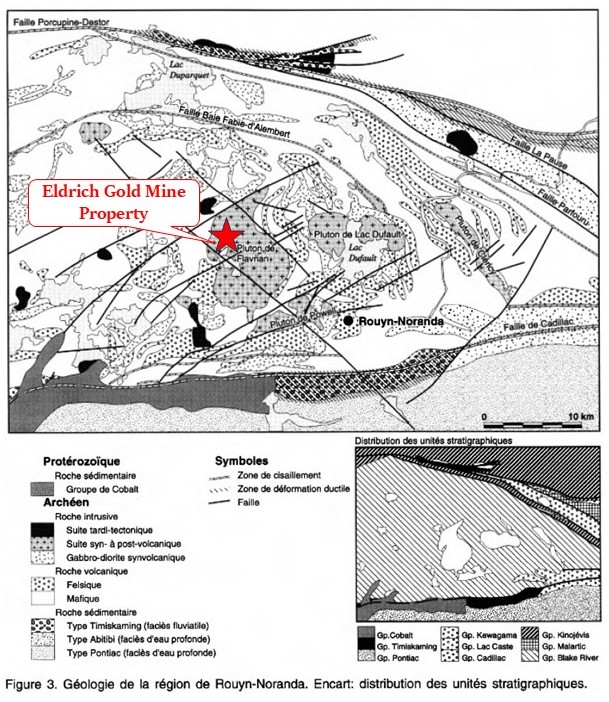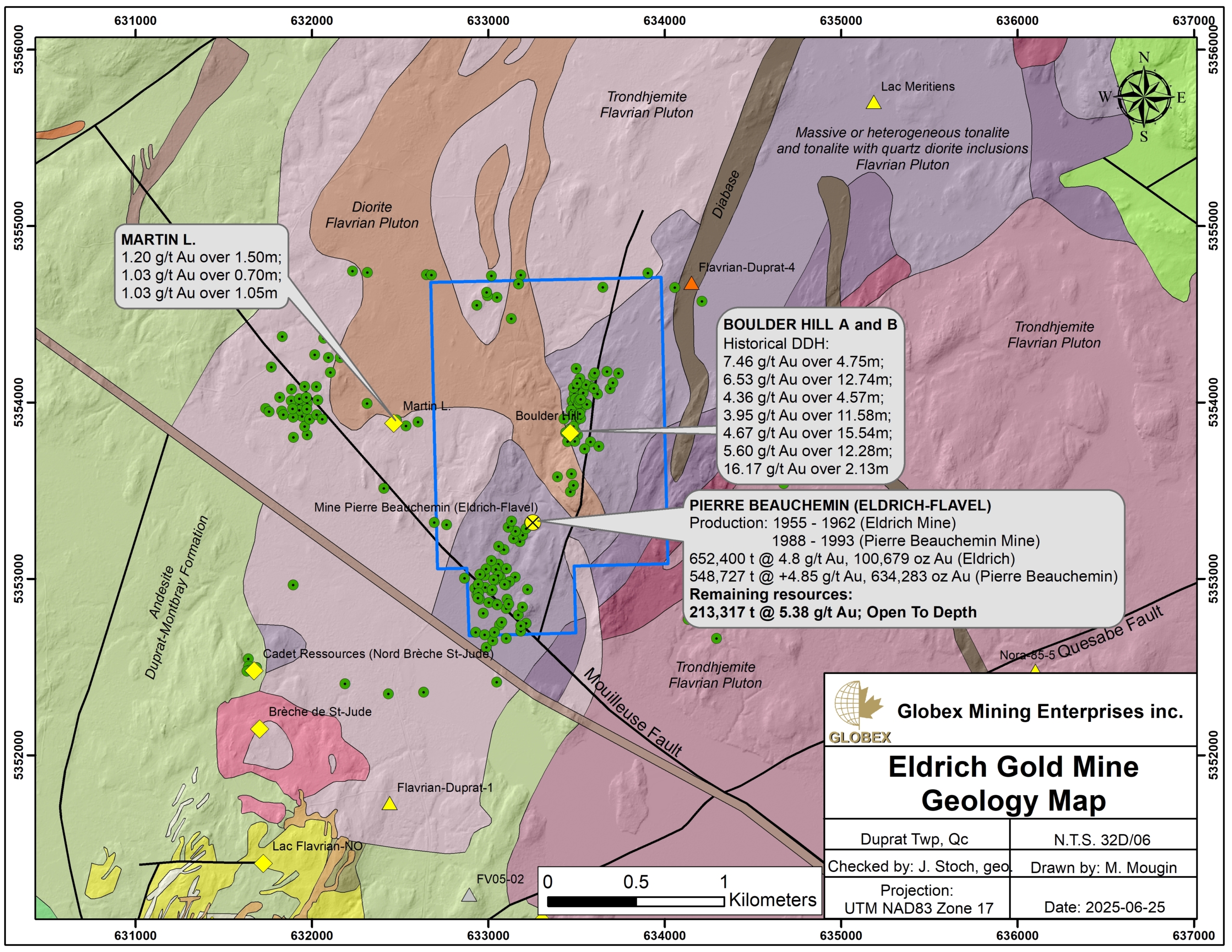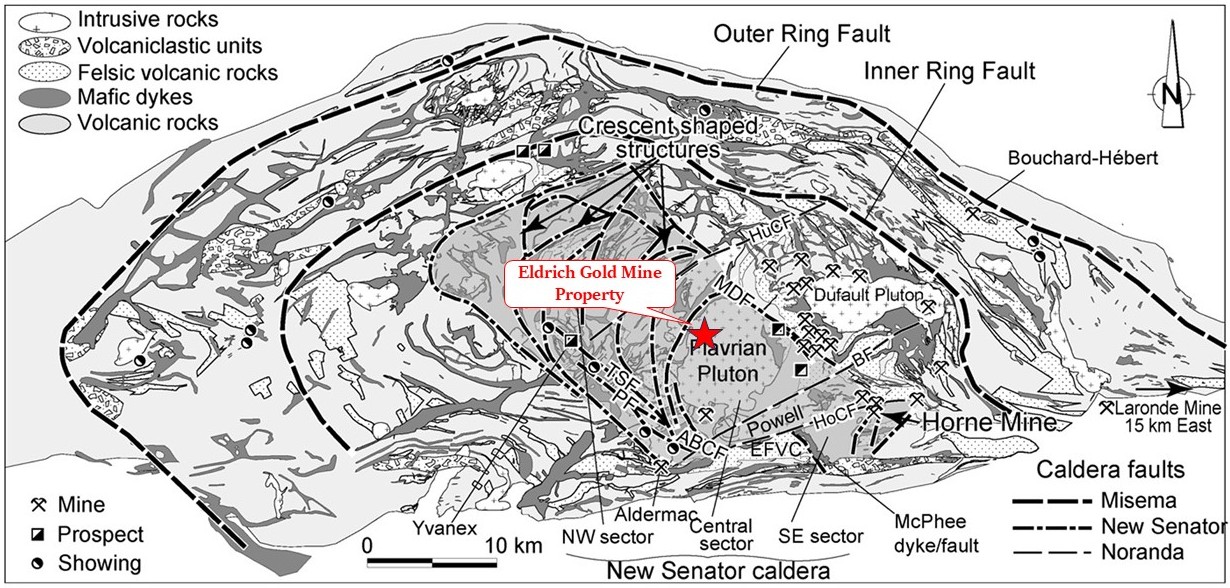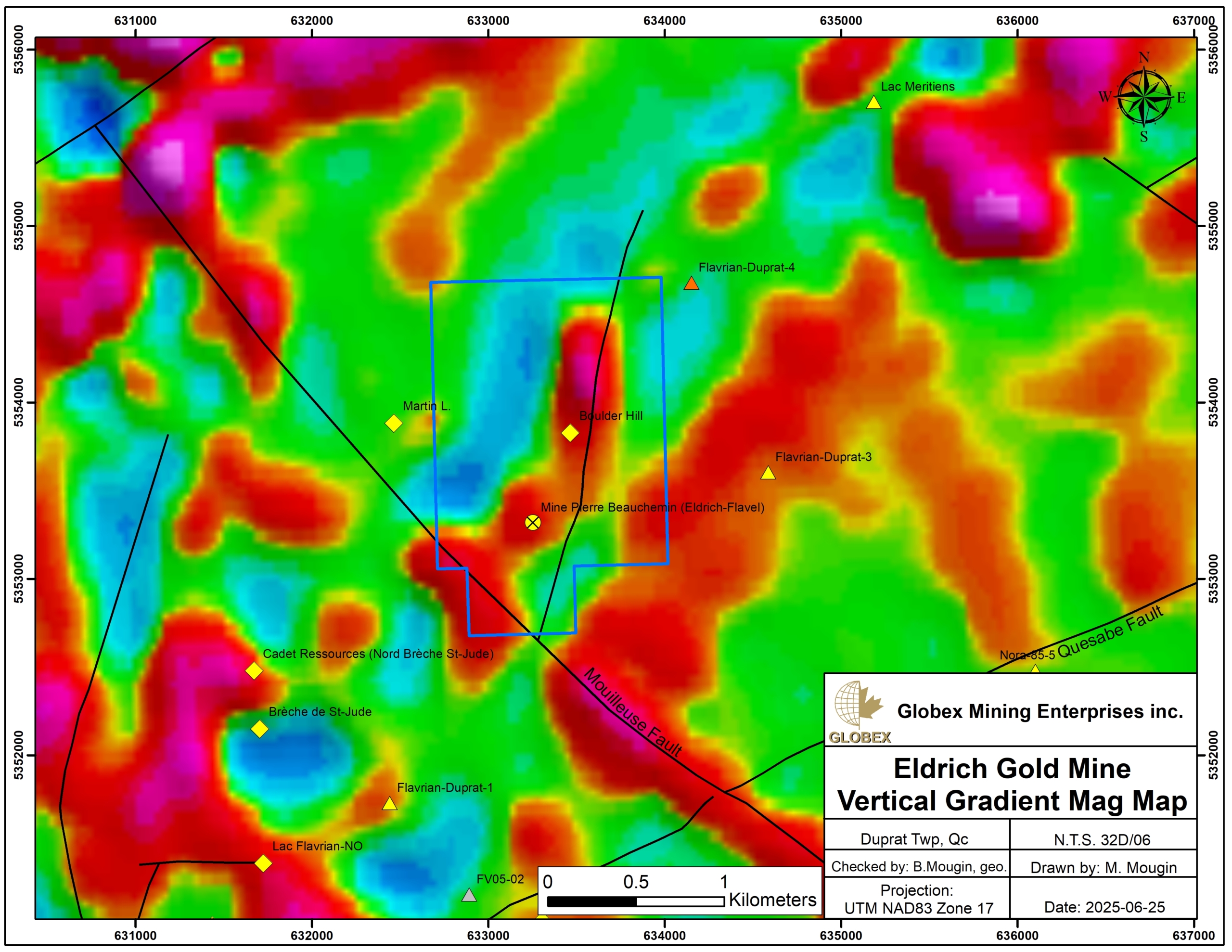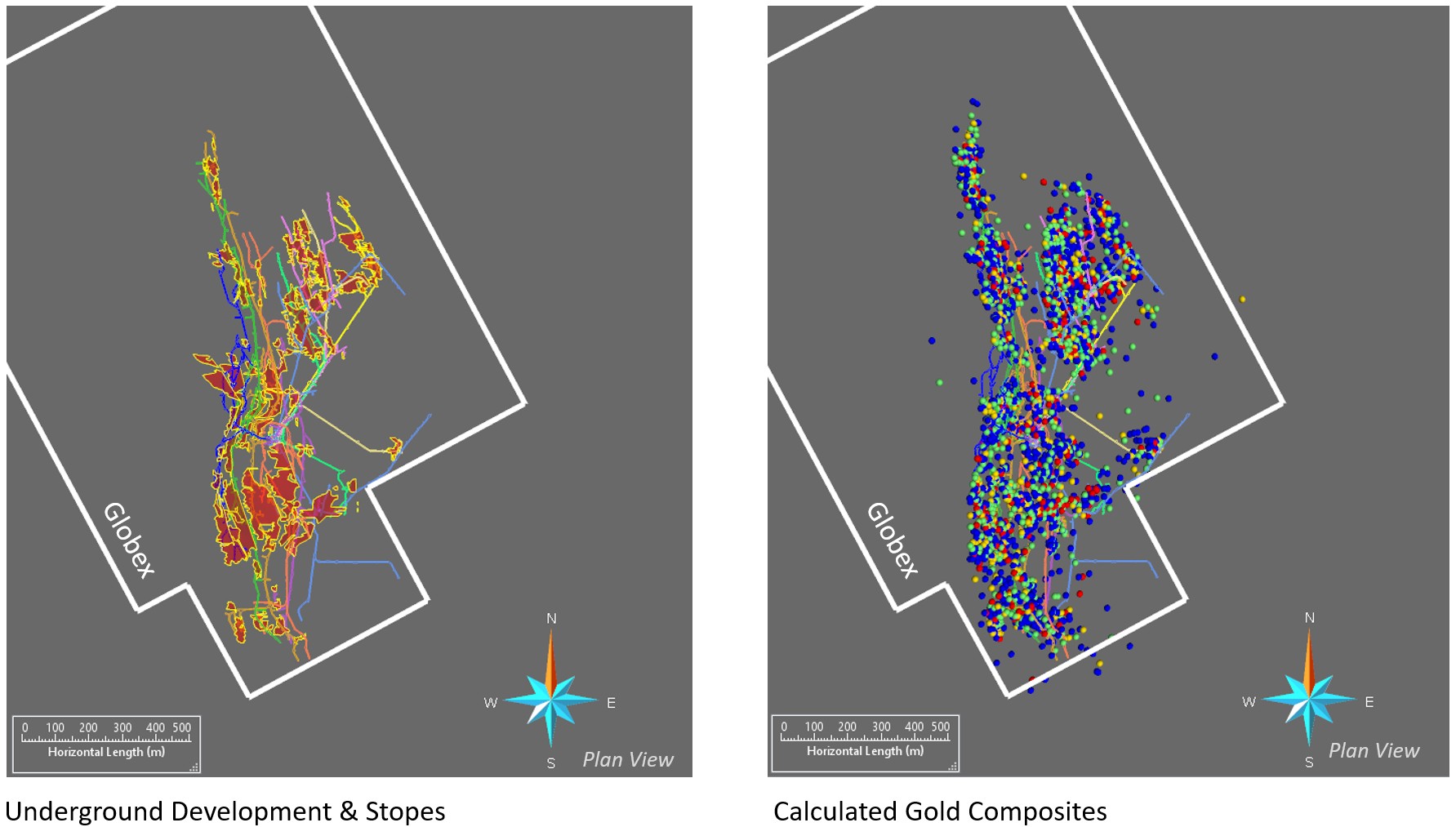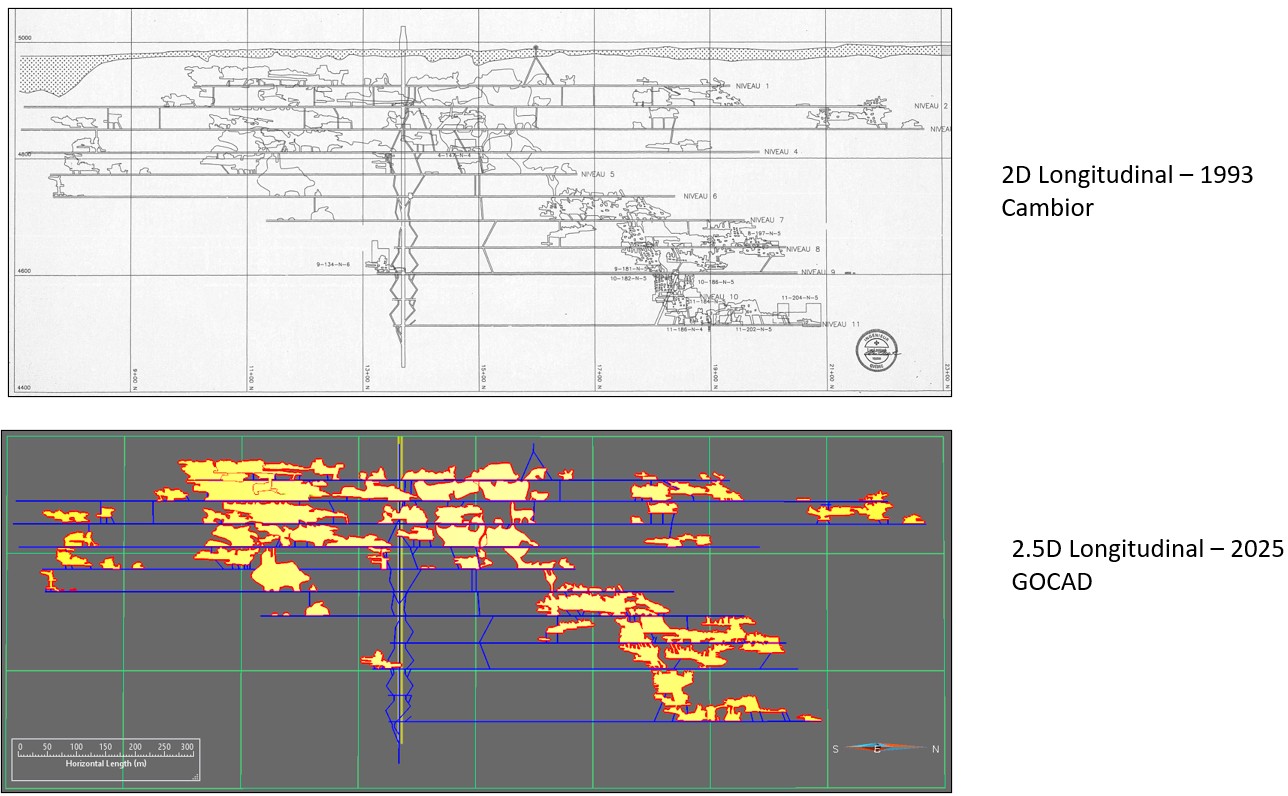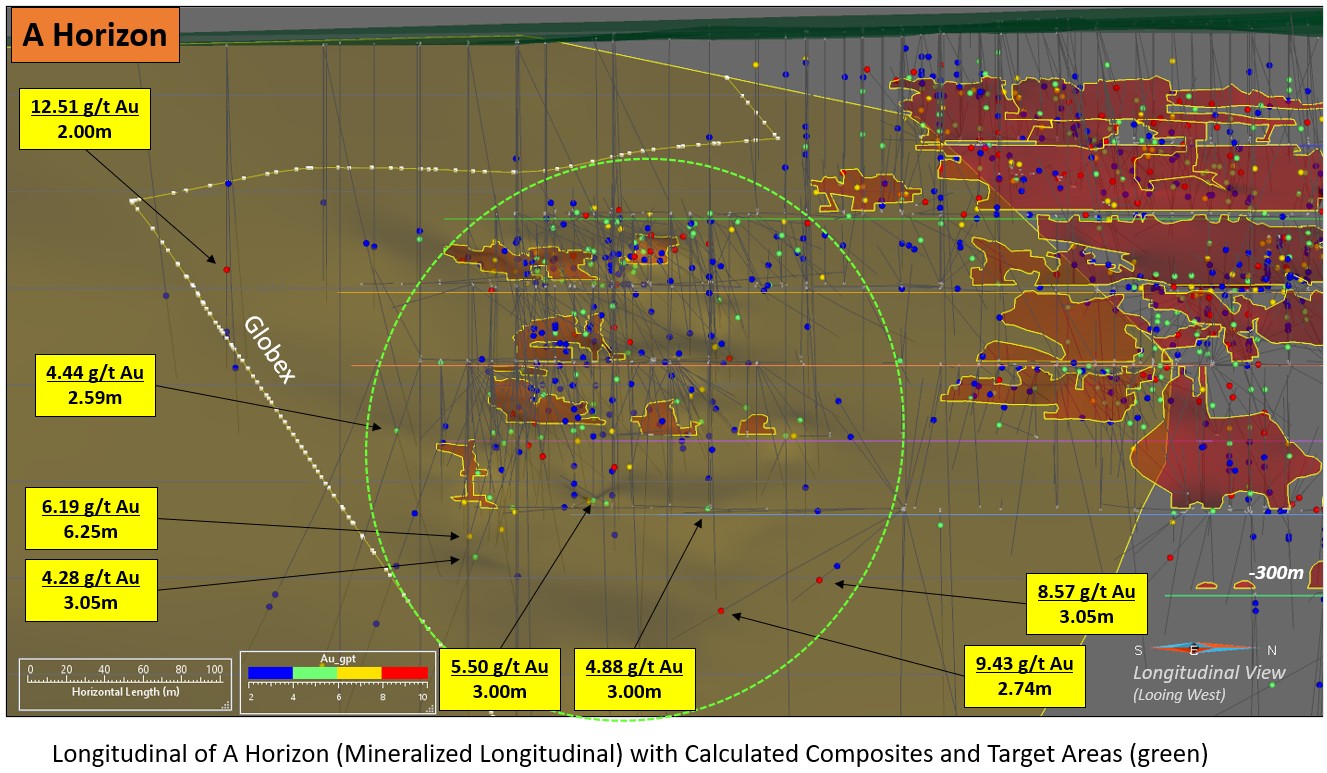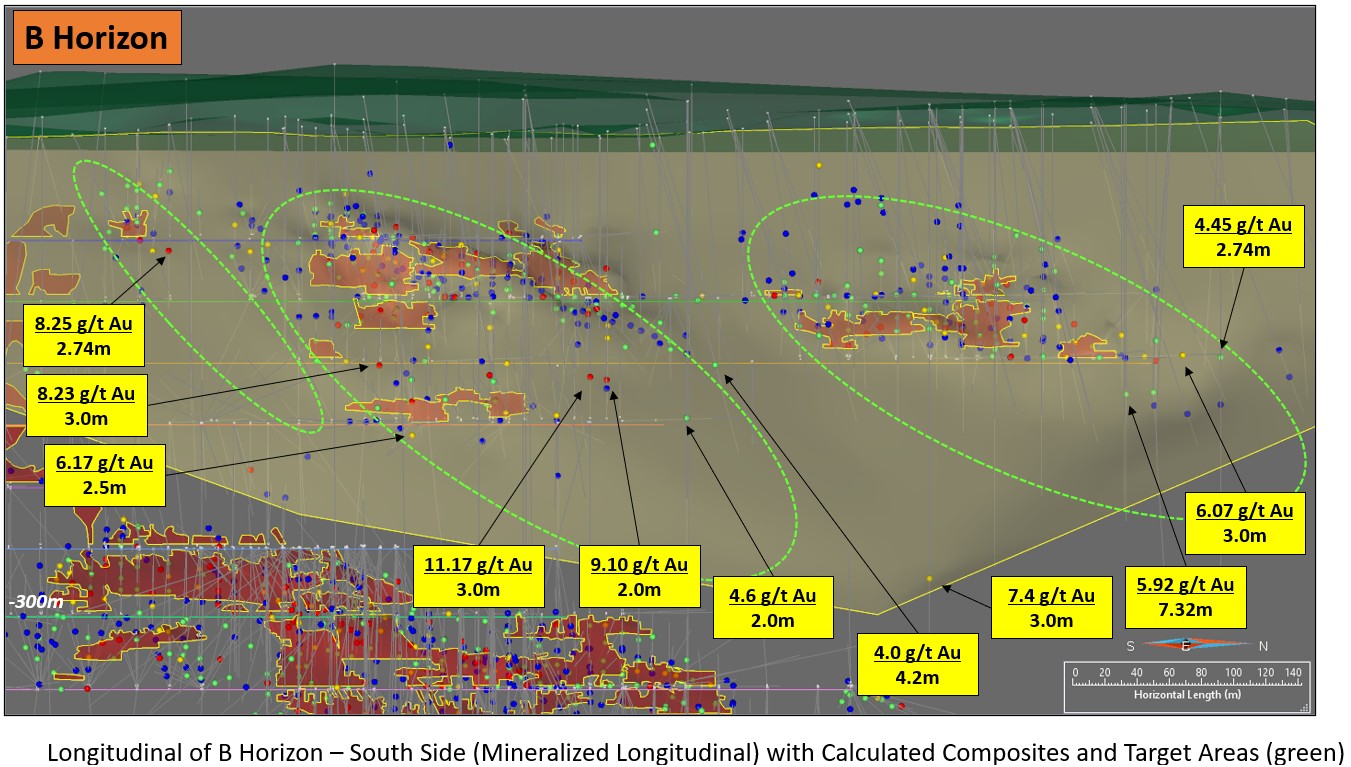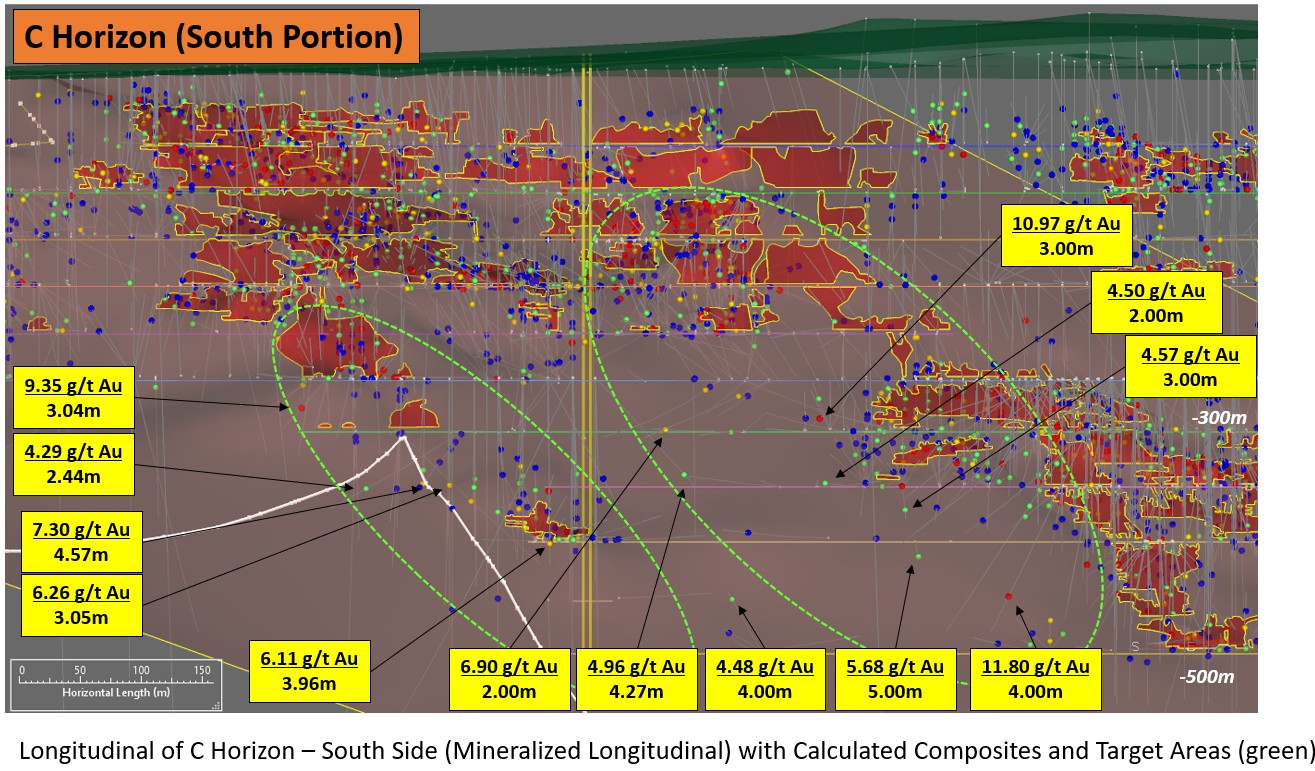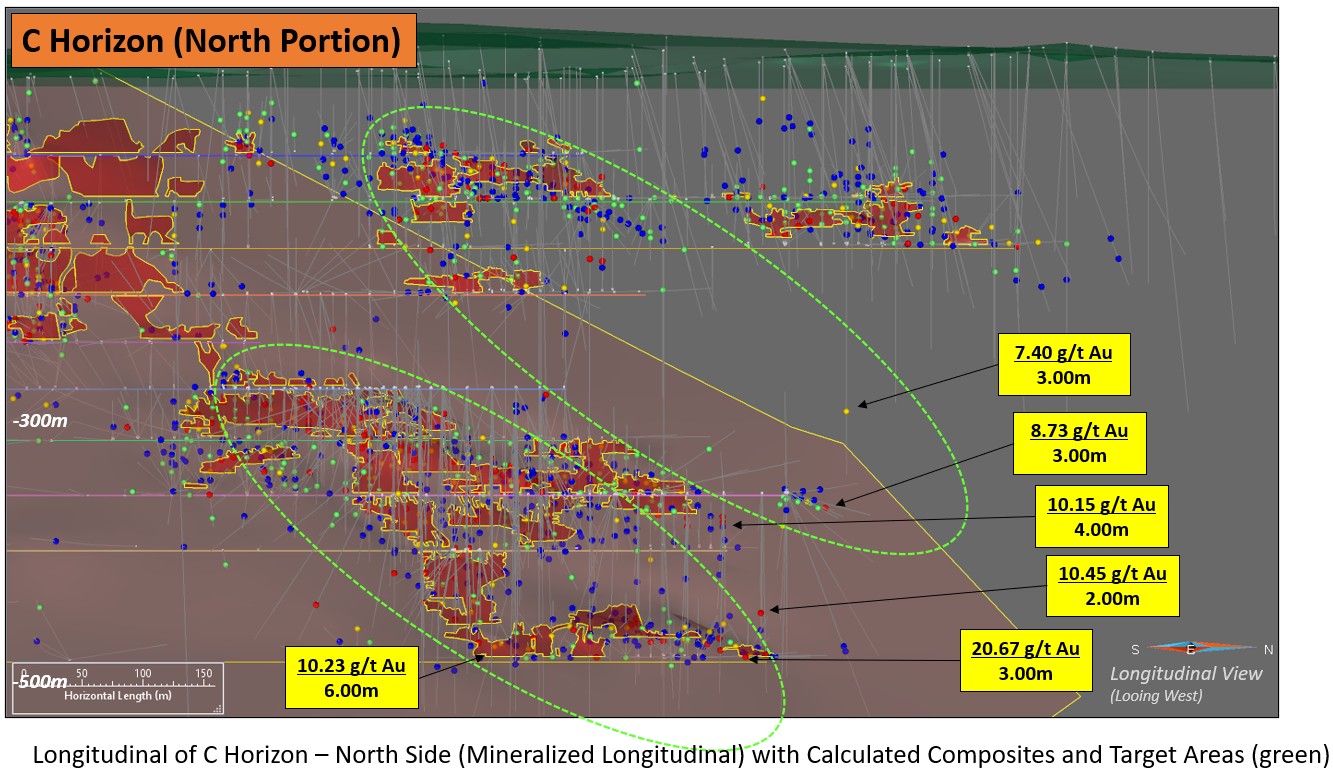Eldrich Gold Mine
Location, Access, Description
The Eldrich Gold Mine property is located in the Abitibi-Temiscamingue region of Quebec Province. It is composed of 8 contiguous mining cells totalling 235.55 ha in Duprat township (NTS 32D06), Abitibi, Quebec. The property is located on public lands, about 15 km northwest of the town of Rouyn-Noranda (Qc). The claims are fully held by Globex and are not subject to any third-party interests.
The property is easily accessible by road from Rouyn-Noranda. Numerous commodities can be found in Rouyn-Noranda regarding contractors, skilled labor, equipment rental, as well as sleep and food accommodation of remote workers, even a smelter.
Geology and Mineralization
Regional Settings
The property is located in the Abitibi Sub-province of the Canadian Shield. The Abitibi Sub-province is formed of Archean volcanic and sedimentary rock assemblages deposited between 2,730 and 2,690 Ma (Chown et al., 1992; Daigneault et al., 2002) injected by large masses of intermediate to felsic plutonic rocks. All these lithologies were deformed and verticalized during the Kenorean orogeny that occurred about 2.7 Ga ago (Percival et al., 2006; Percival, 2007). Regional metamorphism is at the greenschists grade and locally reaches the lower amphibolite grade around large Archean intrusions.
Several regional structural features are listed in the property area ; those include the Beauchastel Fault, the Horne Creek Fault (HCF), the Wasa Shear Zone (WSZ) and the Cadillac Larder-Lake (CLL) Fault. Each of these structures is associated with gold and base metal showings and deposits.
In the Eldrich Gold Mine property area, rocks of the Abitibi Sub-province belong to the Blake River Group (2,701 – 2,696 Ma; Lafrance et al., 2005) which is defined as a bimodal calk-alkaline and tholeiitic subaqueous megacaldeira (Pearson and Daigneault, 2009). The superstructure is formed of at least three distinct and embedded caldeiras (Misema, New Senator and Noranda).
Property Geology
The property lies within the Noranda Caldera which corresponds to the final collapse of the volcanic system. This event produced a N070° oriented graben structure that is delimited by the Horne Creek and Hunter Creek faults. In the Blake River Group (BRG), most of the volcanogenic massive sulphide (VMS) deposits are located in the Central Camp and are strongly linked to the evolution of this caldera (MB2009-19).
Rocks of the Eldrich Gold Mine property consist mainly of intermediate intrusive rocks of the Flavrian Pluton. The Flavrian Pluton lies within the Blake River volcanics, in line with the regional foliation (Rive, 1994). Seismic data revealed that the Flavrian Pluton forms a gently east-dipping subconcordant sill intruded into calc-alkaline units of the Blake River Group (MB96-06).
Kennedy (1984) demonstrated that the Flavrian pluton is a complex composite intrusion comprising at least 5 successive intrusive phases of dioritic to tonalitic compositions. The synvolcanic Flavrian Pluton hosts several gold mineralizations associated with Noranda’s central north and south camps (Mercier-Langevin et al., 2011). It represents the central intrusion of the New Senator caldera and the hydrothermal “engine” of VMS-type mineralization (Galley, 2003; Mercier-Langevin et al., 2011; Mueller et al., 2012).
Regional Metallogeny
The Rouyn-Noranda area is rich in metallic deposits. Since the discovery of the Horne deposit in 1927, mineral resources have been mined from more than 42 mines, including several world-class ones. The region of the Eldrich Gold Mine property contains at least three types of mineralization : 1) volcanogenic massive sulfide (VMS) Cu ±Zn ±Au+Ag mineralization that occurs as disseminations, veinlets or exhalative horizons ; 2) magmatic-hydrothermal mineralization that is mainly related to intrusive and hydrothermal breccia zones ; and 3) orogenic gold mineralization that occurs as weakly pyrite-mineralized quartz + carbonate veins and veinlets.
The Cadillac – Larder Lake fault strikes about 13 km south of the Eldrich property in a roughly E-W direction. This regional structure represents one of the most important gold metallotects in the Abitibi Sub-province and hosts numerous deposits > 100t Au (Kirkland Lake, Kerr-Addison, Sigma-Lamaque, Malartic…).
The Francoeur-Wasa shear zone strikes about 11 km south of the Eldrich property and it is also associated with first-class gold deposits including the former Francoeur mine and Wasamac deposit.
Most of the VMS deposits of the Rouyn-Noranda mining district are located in the Central Camp and are strongly linked to the evolution of the Noranda caldera. Faure (MB2009-19) observed a strong relationship between VMS deposits and some orientations of faults and mafic dykes in the BRG.
Property Mineralization
The Pierre Beauchemin (Eldrich-Flavel) former mine is located in the south part of the Eldrich Gold Mine property. A total of 1,319.4 kg Au and 235 kg Ag has been extracted from the mine in two phases between 1955 and 1993. This gold deposit was discovered in 1927 by surface prospection. Gold mineralisation is associated with up to 5% pyrite disseminations within two networks of quartz-carbonate veins oriented N030°/-40° and N060°. The hostrock is a highly silicified, sheared and fractured intrusive (Flavrian Pluton), in contact with andesite of the Blake River Group.
The property also hosts the Boulder Hill gold showing which was discovered by diamond drilling (DDH) in 1927 too. Gold and copper mineralization consists in pyrite, chalcopyrite, specularite and native gold in a silicified-sericitized granodiorite-trondhjemite of the Flavrian Pluton. Some sections exhibit numerous quartz veins hosting massive pyrite. Best intersections in historical DDH include 4.56 g/t to 38.4 g/t Au over 1.80 m (DDH #15).
Numerous gold and base metals showings and deposits have also been identified in the vicinity of the Eldrich Property, often following the contact zone between the Flavrian Pluton and the volcanics or along secondary faults. Most of these showings appear to be located on positive magnetic anomalies.
History
Following the discovery of the Eldrich-Flavel deposit in 1927, numerous exploration work were carried out in this area by successive owners, including prospection, geological mapping, stripping, channel-sampling, geophysics, geochemistry and diamond drilling (DDH).
Public data of historical work from Sigéom mentions that several DDH programs have been carried-out on the property by successive owners. Eldrich Mines Ltd. drilled the area of the Eldrich Mine during the mid-1950s, followed by SOQUEM, Aiguebelle Exploration Inc and Sullivan Mines Inc during the 1980s. The Boulder Hill area has been drilled too, by North American Asbestos Ltd (1974), SOQUEM (1983) and Sullivan Mines Inc and SOQUEM jointly (1985). A few DDH have been undertaken in the north part of the property by Eldrich Mines (1953 to 1956) and Cambior (1989). The cumulative total of this work represents several thousand metres of core.
The Pierre Beauchemin (Eldrich-Flavel) mine has produced gold ore during two distinct periods. The first one was operated by Eldrich Mines Ltd between 1955 and 1962 and produced 63,808t @ 4.46 g/t Au. The second one was operated by Cambior between 1988 and 1993 and produced 223,727t @ 5.92 g/t Au (Sigéom). Operations ended in the summer of 1993 when reserves were exhausted (DV94-01).
3D modelling of the former mine has been undertaken by Globex in 2024. The underground drifts have been digitized and the DDH database imported. Three (3) en-echelon mineralized horizons were interpreted in a roughly N-S direction. Several unmined zones of interest were identified to be tested by further DDH due to strong gold anomalies not followed up.
Resources and Potential
The geological context of the Eldrich Gold Mine property has already proven to be strongly favorable to the discovery of both gold and base metals mineralization. The Pierre Beauchemin (Eldrich-Flavel) Mine has produced 1,319.4 kg Au and 235 kg Ag between 1953 and 1993. Reserves are supposed to be depleted but recent 3D modelling by Globex highlighted the presence of several strong Au anomalies in DDH hat have not been followed up to date. Further DDH on these anomalies is therefore strongly recommended.
Previous work has also identified numerous gold and base metal showings in the area of the BM property, as well as favorable geological and structural features for the emplacement of both gold and base metal mineral deposits. One of the most researched metallotects for VMS exploration in the Noranda Central Camp is the presence of synvolcanic faults. Research work on VMS fertile synvolcanic faults in the Blake River Group (BRG) by the CONSOREM in 2009 (MB2009-19) highlighted that most fertile faults are associated to the N070° synvolcanic hydrothermal system.
Future work on the Eldrich Gold Mine property should include an exhaustive compilation of historical geoscientific data ; particular attention should be paid to geophysics in order to verify for the presence of IP axis (disseminated auriferous pyrite) and N070° secondary faults (VMS fertile system of synvolcanic faults) on the property. Depending on the amount of historical data available and usable, further geophysical surveys (Mag, VLF-EM, IP) should be considered.

